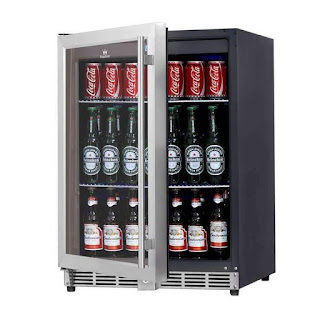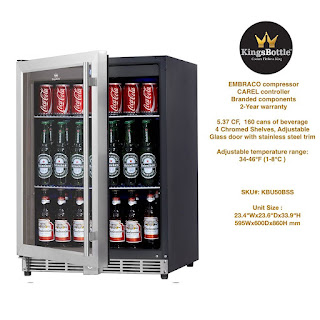What Are The Factors to Consider While Buying a Built-In Wine Cooler?
There are many factors to consider when searching for your ideal under the counter wine fridge. Your needs should shape your search to find a suitable wine cooler, so it helps if you have a clear idea of what you're looking for before you browse.
 |
Here are some of the main categories and specifics you should keep in mind.
Location
Before you go any further, you should have a definite place in your home where a built-in under counter wine fridge should fit. With freestanding models, you have a little more flexibility in terms of placement. Still, built-in wine coolers are designed to be installed in a specific space, usually under the counter, where they will stay and become a feature of your home.
That said, when people most often choose to use a built-in under the counter wine fridge, it's usually because they're building a new home, remodeling their kitchen, or have bought a house with a garbage disposal that they never use. If you fall into the first two categories, you have room to be picky about size and dimensions because contractors can build what you buy (though you want them to work with what you have in mind for the rest of the kitchen).
If you're replacing a trash can or an under-the-counter wine cooler that has stopped working, you'll have precise dimensions to work within. Make sure you take the measurements to end up with a built-in wine cooler that fits the space you are using.
Price
The price of built-in wine coolers can range from around $300 to several thousand dollars, depending on the size, style, and features. Keep in mind that installation costs often add a little extra to the overall upfront cost.
Larger capacity wine cabinets typically cost more than those that hold just a few bottles, and models that include extra features such as a security lock or touchscreen usually cost more as well.
Suppose you're storing delicate bottles in which you've already made a sizable financial investment. In that case, it's wise to invest enough money to buy a built-in wine cooler that works consistently, lasts a long time, and offers all the features you need, as it will protect your other investments.
If you are treating it primarily as a supplementary beverage holder rather than a way to keep expensive wines at an optimum temperature, feel free to opt for a more affordable model in the price spectrum - provided it still offers the looks and features you need.
Wine storage
Power
Capacity is one of the most important factors to consider when looking for an under counter wine fridge. In many kitchens, space is at a premium, and you may need to stick with a smaller model. But if you are not limited to areas, you should focus on how many bottles you want to keep at any one time.
Manufacturers constantly list the number of bottles their wine coolers will hold, but keep in mind that the numbers they provide are usually specific to Bordeaux-style bottles. Since bottle sizes vary depending on the type of wine you buy, what will fit in your wine cooler at any given time will change depending on your wine type.
If you have a set number of bottles that you know you need to fit in your wine cooler to be happy with your purchase, it is wisest to choose a wine cooler that claims to have a more significant number than what you have in mind. This will leave you with a bit of room to accommodate bottles of pinot noir and champagne and more OK bottles of Bordeaux and riesling.
Number of zones
Many built-in wine coolers come with a single zone, which means that all bottles are kept at basically the same temperature (with a slight difference between the top and bottom as the heat rises).
Some under counter wine fridge - usually larger ones - have two zones. This means you can store your red wines at a different temperature to your white wines. Any collector who loves both red and white wine probably already knows that the ideal temperature for storing both wines is different. Dual zones wine fridge makes it easier to care for both sets of wines without buying an extra cooler.
Style
If your only priority is proper storage, you may not need to worry about style. But if you want a wine cooler that also looks good (and why not?), you have plenty of options to choose from that look great.
Many built-in wine coolers come with bright LED lighting to enhance their appearance. And wine coolers come in a range of colors, so you can decide exactly which cooler best matches the rest of your kitchen.
When it comes to looks, everything is subjective. Take a look around and see if there's anything you find particularly interesting. Then imagine a nice built-in wine cooler in the room where you want to install it. Does that fit in with your rest of the room? Or does it look just right for you?
A built-in model has a certain permanence to it - you are not tied to it forever, but you want to stick with it for the long haul. Please make sure you're happy with how it looks before you install it.
Noise
Our lives are already filled with noisy appliances. Can your home handle one more? As mentioned earlier, thermoelectric wine coolers are predominantly chosen precisely because they are quieter.
If you live in a house with good air conditioning throughout the summer, or if you are not too concerned about the temperature consistency of your wine cooler, it can be easy to sacrifice these benefits for a quieter wine cooler.
Suppose your priority is the proper cooling of precious wine bottles. In that case, you should choose a model with a higher compressor to achieve better consistency at higher outdoor temperatures - especially if you live in a place where it's often hot in the home.
How to buy a built-in wine cooler?
Shelf life
No one wants to spend money on a wine cooler that won't last, and that's especially true if you've gone to the trouble of having it built into your home. The best way to get an idea of what to expect from the durability of your wine cooler is to research the brand's reputation and read reviews of the model itself.
You may need to spend a bit extra money to ensure you're investing in a wine cooler that's made to last. While it may save you the disruption of storage time (which can ruin or damage the wines you store), the cost of a new wine cooler and having to disassemble and reinstall a new fridge - a few hundred dollars more immediately starts to seem like a much better deal.
Energy consumption
Every refrigerator you buy uses a lot of energy, and under-counter wine coolers are no exception. You should expect your energy bills to go up no matter which model you buy, but some will cost you less energy over time than others.
Thermoelectric models are known to use less energy than their compressor models. As you would intuitively expect, smaller capacity wine coolers use less energy than large capacity wine coolers. And you can find some models that manufacturers have worked to make more energy-efficient, and marked as such. If you want to buy 2-Zone Under Counter Wine Fridge in Australia, KingBottle is one of the best options for you.





Comments
Post a Comment